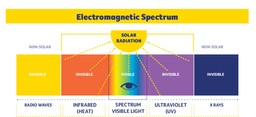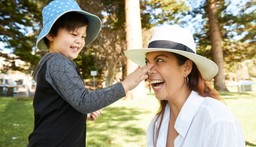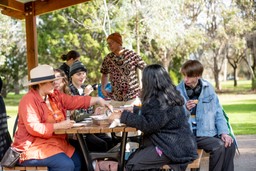Australia has one of the highest rates of skin cancer in the world. Fortunately, being SunSmart is easy and can reduce your risk of skin cancer.
Here, we cover everything you need to know about protecting your skin from cancer by answering your most commonly asked questions about sun protection.
10 Fast facts about sun protection
Fact 1: Skin should be protected whenever UV radiation level reaches 3 and above.
- A UV radiation level of 3 is high enough to cause damage to unprotected skin, therefore it is important to protect your skin whenever UV reaches 3 and above. The higher the UV radiation level, the greater the potential for skin damage. Too much UV radiation from the sun can cause sunburn, skin damage (e.g. wrinkles, tanning, blotches and other signs of ageing), eye damage and skin cancer.
- UV radiation cannot be seen or felt and is different to infra red radiation, that we feel as heat, therefore UV levels are independent of temperature. The UV radiation level is determined by multiple factors including, the angle of the sun to the earth’s surface, but not temperature. UV radiation levels peak over the middle of the day when the sun is directly overhead.
- UV radiation can be high even on cool and cloudy days, so clear skies or high temperatures can’t be used to determine when sun protection is needed. This means skin damage and sun burn can occur even on windy, cloudy and cool days.
- Sun damage is caused by ultraviolet (UV) radiation, not temperature. A cool or overcast day in autumn or summer can have similar UV levels to a warm, sunny day. If it’s windy and you get a red face, it�’s likely to be sunburn. There’s no such thing as ‘windburn’.
- Sun damage is also possible on cloudy days, as UV radiation can penetrate through clouds, and may even be more intense due to reflection off the clouds.
- Download the SunSmart app to check the daily local sun protection times.
Fact 2: A fake tan may darken the skin, but it does not protect the skin from UV.
- Fake tanning products do not protect the skin from damage caused by overexposure to UV radiation. While fake tans can have an SPF rating, this should not be relied on as primary protection. For optimal protection against UV, apply a SPF 50 or higher, broad spectrum (UVA and UVB) water-resistant sunscreen whenever the UV reaches 3 and above, even if you are wearing a tan.
Fact 3: Sunscreen is still necessary even when using make-up and cosmetics with SPF.
- Unless cosmetics are labelled with a rating of SPF 50 or 50+, a separate sunscreen product should be applied underneath your makeup. An SPF 50 or 50+, broad-spectrum sunscreen can be easily incorporated as part of your daily morning routine whenever UV is expected to be 3 and above. For extended periods of time outdoors, sunscreen should be reapplied every two hours—not just once in the morning. Be aware that most cosmetic products offer either no protection against UV or protection that is much lower than the recommended rating of SPF 50 or 50+.
Fact 4: Regardless of skin tone, UV can damage unprotected skin when UV reaches 3 and above.
- Regardless of skin type, overexposure to UV radiation from the sun and other artificial sources, such as solariums, can cause skin damage. Skin damage from UV radiation is cumulative and irreversible and increases the risk of skin cancer. People of any skin tone can get skin cancer as they can still receive enough UV exposure to increase risk of developing skin cancer. Care still needs to be taken outdoors—even if you’re not in direct sunlight—by protecting your skin whenever the UV is 3 and above.
Fact 5: Sunscreen—no matter how high the SPF—is not a suit of armour.
- Sunscreen—including those with the recommended SPF rating—should never be used to extend the amount of time you spend in the sun.
- Though it may sound like there is a big difference, SPF 50 only offers marginally better protection from UVB radiation, responsible for causing sunburn and adds to skin cancer risk. SPF 30 sunscreens filter approximately 96.7 per cent of UV radiation, while SPF 50 sunscreens filter 98 per cent of UV.
- Cancer Council recommends applying an SPF 50 or 50+, broad-spectrum sunscreen, ideally 20 minutes before heading outside, and reapply every two hours when remaining outdoors, or more often after swimming, sweating, or towel drying.
Fact 6: People in Australia can usually get their daily dose of vitamin D in just a few minutes when the UV is 3 and above.
- The sun’s ultraviolet (UV) radiation is both the major cause of skin cancer and the best natural source of vitamin D. In Australia, we need to balance the risk of skin cancer from too much sun exposure with healthy exposure to maintain vitamin D levels. People in Australia shouldn’t overexpose themselves to potentially harmful UV in order to get more vitamin D.
- Research suggests prolonged sun exposure does not further increase vitamin D levels but does increase the risk of skin cancer. When UV levels are 3 or above, most people get enough vitamin D with just a few minutes of sun exposure on most days while completing everyday tasks—like walking to the car or shops. Sun protection isn’t only needed during peak UV times, it’s needed whenever the UV is 3 and above. This is when you’ll need to protect your skin in five ways—slip, slop, slap, seek and slide.
- Sun protection generally isn’t necessary when UV levels are below 3, to promote vitamin D. If you live in those parts of Australia where UV levels are below 3 in winter, you can help maintain vitamin D levels by spending time outdoors in the middle of the day and doing some physical activity. People who may be at higher risk of vitamin D deficiency include people with naturally very dark skin, people with conditions or medications that impact vitamin D absorption, those who cover their skin for religious or cultural reasons and those with little or no sun exposure. If you are concerned about your vitamin D status, speak to your doctor.
UV radiation from the sun causes skin cancer, but it is also the best natural source of vitamin D, which is needed to develop and maintain strong and healthy bones.
In Australia we need to balance the risk of skin cancer from too much sun exposure with maintaining vitamin D levels.
What is vitamin D and why is it important?
Vitamin D forms in the skin when it is exposed to UVB radiation from sunlight. Some foods, such as oily fish and eggs also contain small amounts of vitamin D, while margarine and some types of milk have added vitamin D. However, food only makes a small contribution to the body’s overall vitamin D levels and it is difficult to get enough from diet alone.
We need vitamin D to maintain good health, in particular to keep bones and muscles strong and healthy.
How much sun do we need for vitamin D?
When the skin is exposed to UV radiation from the sun, vitamin D is formed through a series of processes that start in the skin.
The amount of sunlight you need for vitamin D depends on several factors, including age, the UV level, your skin type and your lifestyle. UV levels vary across Australia, so the time you need to spend in the sun will be determined by your location, the season, the time of day, cloud coverage and the environment.
The body can only absorb a limited amount of vitamin D at a time. Extended periods of time in the sun does not increase your vitamin D levels, but they do increase your skin cancer risk.
When the UV Index is 3 or above (August–May in South Australia), incidental sun exposure—such as walking from the office to get lunch or hanging out the washing—is enough for most people to produce the required vitamin D levels, even when wearing sun protection.
In June and July, when the UV Index typically falls below 3 in southern states, we recommend spending time outdoors in the middle of the day with some skin uncovered on most days of the week to support vitamin D production. Being physically active (e.g. gardening or going for a brisk walk) may also help to increase vitamin D levels.
If I protect myself from the sun, will I still get enough vitamin D?
Sensible sun protection when UV reaches 3 and above does not put people at risk of vitamin D deficiency. When sunscreen is tested in laboratory conditions it is shown to block vitamin D production, however regular use in real life has been shown to have little effect on vitamin D levels. This is probably because sunscreen doesn’t block 100 per cent of UV radiation so your skin is still exposed to small amounts of UV, even when sunscreen is applied liberally. People who use more sunscreen also spend more time in the sun, so naturally they will have higher vitamin D levels.
When do I need sun protection?
Most people in Australia need sun protection when the UV Index reaches 3 and above. The UV Index is an international standard measurement of the strength of UV radiation from the sun at a particular place on a particular day. UV levels are lower in the early morning as the sun comes up, gradually increasing to a peak around the middle of the day when the sun is at its highest, and then decreasing slowly as the sun gets lower in the sky.
In northern parts of Australia (like Brisbane and Darwin), UV levels are above 3 all year round and reach extreme levels of 14+ in summer, so sun protection is needed daily.
In southern parts of the country, there are times of the year when sun protection is not necessary. For example, in Adelaide, the average daily UV levels remain below 3 in June and July, so sun protection is not required unless you are outside for extended periods or near highly reflective surfaces like water.
You can access the free SunSmart app to find out the daily sun protection times for your location.
Who is at risk of vitamin D deficiency?
There are groups within the population that are at higher risk of vitamin D deficiency including:
- people with naturally very dark skin—the melanin in dark skin affects UV penetration so you need more UV exposure to make vitamin D
- people with little or no sun exposure (e.g. older adults who are in residential care or housebound; those who wear concealing clothing for religious or cultural purposes; those who deliberately avoid sun exposure for cosmetic or health reasons; those who are hospitalised for a long time; those with a disability or chronic disease; and night-shift and indoor workers, such as office or factory workers who have limited incidental UV exposure throughout the day)
- breast fed babies who fall into the risk categories above or have mothers with low vitamin D—breast milk contains little vitamin D and infants depend on maternal stores initially. (Formula milk is fortified with vitamin D)
- people with health conditions (obesity, end stage liver disease, renal disease and fat malabsorption syndromes such as cystic fibrosis, coeliac disease, inflammatory bowel disease) or medications affecting vitamin D metabolism.
If you’re concerned about your vitamin D status , consult your GP. Vitamin D levels can be checked with a blood test, and your GP can advise on options, such as supplementation, depending on your individual circumstances.
Fact 7: Skin cancer is serious.
- Skin cancer treatment can be much more serious than simply having a lesion ‘burnt off’. It can include surgery, chemotherapy and can result in permanent scarring. Skin cancer can also spread to other parts of your body. Each year, around 2,000 Australians die of melanoma and non-melanoma skin cancers combined.
- Be alert for any new spots or changes to existing spots and consult your GP immediately if you notice anything new or changing. And remember, prevention is always better than cure. Download our FREE skin check guide..
Fact 8: Anyone can be at risk of skin cancer.
- Excessive exposure to the sun does not just happen when deliberately seeking a tan. In a high-UV environment like Australia, we can be exposed to dangerous levels of UV radiation during all sorts of daily activities, such as working outdoors, gardening, walking the dog or having a picnic. This sun exposure adds up over time, increasing the risk of skin cancer.
Fact 9: There is no such thing as a safe tan.
- When skin darkens it is a sign of skin damage due to skin cells experiencing trauma, even if there is no redness or peeling. Skin darkens as a way of trying to protect itself because UV radiation is damaging living cells. If you tan easily, you are still at risk of skin cancer and should still use sun protection measures when the UV reaches 3 and above.
Fact 10: You can still get burnt through a car window.
- The glass commonly used in car side windows reduces, but does not completely block, transmission of UV radiation. This means you can still get burnt if you spend a long time in the car next to an untinted side window, when the UV is high. More commonly, people are burnt in cars with the windows down, where they can be exposed to high levels of UV radiation.
This webpage was last reviewed and updated in November 2022.


